Our Favorite Isekai Titles Are...
by ANN Editorial Team,One of the fastest-growing genres in anime is isekai. Each season, variations of these otherworldly adventures appear on screens, usually featuring an unfortunate Japanese salaryman who met his end only to reawaken in some form in a traditional fantasy setting. As the years passed, new spins on the formula have emerged; sometimes, the fantasy world denizens end up on modern earth; sometimes, that other world is a beloved dating sim; sometimes, it's a randomly-spawning restaurant with a mouthwatering menu; and many more. Isekai spans comedy, adventure, romance, and sci-fi genres.
We asked our editorial team to pick their favorite isekai anime. Below are our picks for newcomers to the genre or seasoned travelers looking for something different.
The Executioner and Her Way of Life
Dawn H.
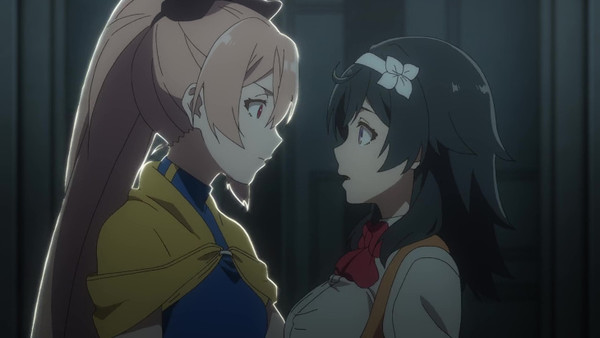
In a sea of modern isekai titles, it's easy to let one (or many) slip through the cracks, especially if you've grown exhausted of the genre and its trappings. I feel like this happened with The Executioner and Her Way of Life—a 2022 isekai series that I never really saw a lot of folks talking about, which disappointed me a bit because I enjoyed it. The series revolves around Menou, a priestess who works for The Church in a world parallel to ours, where people from Japan will sometimes be transported. Through their journey, they will gain magical powers that will make them dangerous to the people of Menou's world, so it's her job to carefully and promptly eliminate these “Lost Ones” from another world before they become a dangerous threat.
All that changes when Menou meets Akari, a kind, somewhat clumsy, run-of-the-mill young woman whom Menou has been ordered to execute. Menou soon discovers that there is more to Akari than what she assumes at first blush, which leads her to take Akari on a journey through her world to try to find some answers. Why exactly was Akari brought here? What are her mysterious powers? And why does Menou keep feeling these strange instances of déjà vu? Through this adventure, Menou and Akari get to know each other better day by day. While Menou has always prided herself on being the secretly cold and calculating Top Executioner who always got the job done, she's suddenly finding herself having thoughts of doubt---she couldn't possibly be falling for Akari....could she?
One of the stand-outs of The Executioner and Her Way of Life is the world-building. A lot of thought and care went into crafting Menou's parallel world, which gives it a richness that I was pleasantly surprised with. The history of “The Lost Ones” and the tragedies that befell Menou's people was not something I was expecting, and the more you learn about it through her travels and her relationships with other characters throughout the series, the more you understand just how she became the hardened Executioner she is now.
The character writing also stood out to me and got me hooked early on. I was thrilled to see obvious sapphic romantic plots and sub-plots almost right away, and they weren't being played up as jokes. While there are plenty of isekai comedies where relationships with women blossom, I always felt like the tones of those series were way too goofy for me. While there may be a few gags here and there in this series, for the most part, it's a more serious fantasy adventure that doesn't take life and death lightly—there's a surprising amount of blood and violence in this series, and some action scenes that are pretty well done for a TV anime. There are a few instances where the series introduces you to characters you think will be nothing more than a flat representation of a well-worn stereotype, but will later surprise you with a turn you might not have been expecting.
Overall, my biggest gripe with The Executioner and Her Way of Life is that...there's only one season! Since this is based on a light novel series, there's still way more story to tell outside of this short anime adaptation, and I keep hoping that maybe it'll get picked up for more once the novels are closer to being finished. Until then, if you're looking for a great fantasy with compelling twists, turns, some legitimate gore & body horror, and some lesbians that don't know whether they want to kiss or kill each other, give The Executioner and Her Way of Life a try!
Grimgar of Fantasy and Ash
Rebecca Silverman
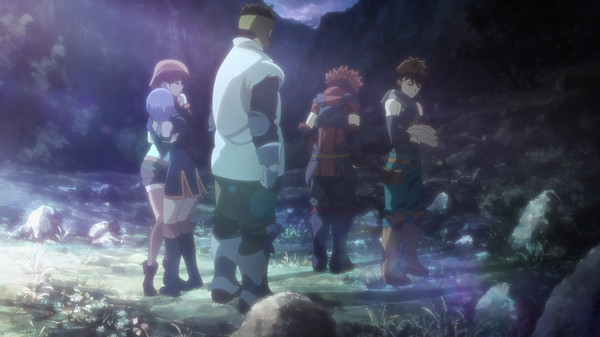
Grimgar of Fantasy and Ash is the show I've thought about the most over the last ten-odd years, and it remains the most meaningful portrayal of mourning in anime (and light novels) for that same span of time. It is perhaps the series ' greatest achievement that it manages to do that without becoming too self-serious. The story follows a group of transported people as they begin their new lives in an RPG-inspired fantasy world, which sounds pretty basic. But the catch is that none of them remember what brought them to this new world, meaning that they're forced to try to recalibrate their expectations with only the barest understanding of what those expectations were or should be. And while their new lives follow the structure of a Dungeons & Dragons style story, there's one major catch: death is forever.
That's an interesting element of the story, not because it makes the series unrelentingly dark (although it does), but because it plays into the mystery of what brought everyone to the new world in the first place. Did they die back in our world? And does that make this new one the afterlife in a heaven/hell sense or in a purgatory way? The series' brief runtime doesn't clear that up for us, and we're forced to draw our own conclusions, but that doesn't necessarily drive the plot. Because despite the weight Manato's death carries and the pall his death casts over the series, ultimately Grimgar is about survival – and whether just surviving is enough. If I'm allowed to quote myself from a piece I wrote in 2016, “Grimgar's peculiar strength is in the way it presents it with no flourishes, just the stark reality of what it's like to lose someone close to you and how everyone goes through the mourning process a little differently. It doesn't skip over the ugly details or how long it can take to get through a death – it suggests that we don'tmove on, we just learn how to get through.”
In a genre that has always been about escapism – my all-time favorite isekai anime series is the original El-Hazard OVAs – Grimgar of Fantasy and Ash does something different. But it's also not grimdark, playing with horrible themes and evil people just because it can. Manato doesn't deserve to die. PKers or a vicious game system doesn't kill him. Instead, the story uses its darkness to make a point about death and mourning and the toll it can take, and it never loses sight of that. It's not a series I ever want to watch again. But it is one that I think about whenever the bell tolls.
The Saga of Tanya the Evil
Richard Eisenbeis
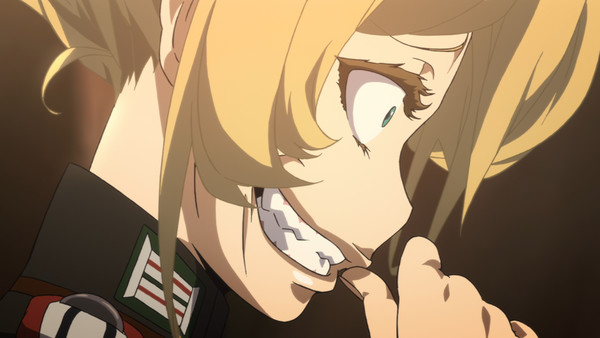
The Saga of Tanya the Evil's most obvious departure from typical isekai fair is its setting. Rather than taking place in your typical copy-and-paste, cliché Western fantasy world, this anime takes place in a world similar to ours. Set in the early 20th century, the technology is around what you'd expect for the most part. There are guns and mortars, cars and trains. Electric lights illuminate the streets, and travelers are increasingly using airplanes. However, there is one major difference between this world and our own: the existence of magic.
In an industrialized world, magic has become little more than a weapon of war. Mages serve as a proto-air force of sorts. They are used for scouting missions and aerial bombardment—or to stop squads of enemy mages from doing the same. In a world where the concept of aerial superiority has yet to be fully understood, they are often treated as expendable—far less valuable than the soldiers fighting on the ground. This world is where our “hero”—once a salary man, now a child mage—finds themselves reborn. Or, more specifically, into this world's equivalent of Germany in a time where events are quickly building to the outbreak of a World War.
On a thematic level, The Saga of Tanya the Evil is a story of one person's hubris—their stubborn inability to recognize and admit their own mistakes. Simply put, Tanya is a psychopath. She lacks empathy and tends to view things strictly by the numbers. This is what got her pushed in front of a train by a disgruntled former employee in her first life, and it caused her to be isekai'd. She is so arrogant, so utterly sure her worldview is correct, that when she met god upon her death, she lectured the divine entity—explaining humanity had grown so comfortable with peace in the modern era that they were beyond the need for gods. God decided to test this assertion by putting the most stubborn atheist he could find into a world filled with war and endless strife, namely, Tanya herself.
This is the overarching pattern of the story. Tanya is the cause of the majority of the problems in her life. Time and again, she overcomes a seemingly insurmountable task, but how she accomplishes the task creates a domino effect of unintended consequences that lead to even larger trials further down the road. Simply put, Tanya's cutthroat way of seeing the world is so alien to the normal people she interacts with—even career soldiers—that her motives are constantly misunderstood. This is compounded by the fact that, despite having the mind of a psychopathic middle-aged man, she has the body of a previously malnourished 10-year-old girl.
In other words, the anime is a cycle of karmic justice. Yet, despite Tanya being undoubtedly evil (just as the title suggests), it's hard not to root for her. This is partly because her true goal is one we all share: a peaceful life (even if she's terrible at achieving it). It is also partly because of her voice actress, Aoi Yūki, and her range of playing a chi,ld going from somber reflection to abject rage with utter perfection.
If you're looking for an isekai story that breaks the standard fantasy mold and instead tells the historical fiction tale of “What if World War I or II happened to involve magic?” then this is the show for you. It has action, comedy, human drama, and even philosophical musings all rolled into one complete package.
Dragon Quest Your Story
Lucas DeRuyter

It's amazing how special Dragon Quest Your Story feels, considering it only makes a few tweaks to the well-established isekai ethos. Rather than be about how video games are broadly awesome, it's about how specifically Dragon Quest V: Hand of the Heavenly Bride is a unique feat in the gaming medium. Instead of being a power fantasy for our male protagonist, it's about how much the world, story, and characters affected him. Last but not least, this film is a joyous affair that is entirely itself rather than a repackaging of tropes and trends that a presumed young male audience supposedly thinks are cool.
All of that being said, Dragon Quest Your Story is a weird movie! It's initially presented as a straightforward adaptation of Dragon Quest V, an intergenerational epic that expertly uses the affordances of the video game medium to give it the scope and impact of culturally defining tombs like Beowulf or Tolkien's high fantasy works. However, at the climax of the film, it's revealed that the protagonist, Luca, is a Dragon Quest fan playing a new VR version of the game. This last-minute isekai reveal recontextualizes the entire movie and transforms it from a direct adaptation of the game to an expression of how this art affected Luca and people like him. This theme is made even more clear when the final boss of DQV, is replaced by a virus that threatens to destroy the world of the game and calls Luca a loser for caring so much about it. Luca then defeats this virus with the help of a Slime delightfully voiced by Steve Blum in the English dub, and in doing so, makes a potent statement on how art, and specifically Dragon Quest V, can affect people as much as more material, or “real,” people and events.
This is bizarrely meta, as Dragon Quest Your Story is already a movie adaptation of what was a nearly thirty-year-old video game when the film was released, and therefore, an inherent celebration of Dragon Quest V. In making Your Story a stealth isekai, the motivations behind creating the film are literalized within the work in a way I haven't been able to stop thinking about since I watched the movie. The teams who worked on it, Shirogumi and ROBOT Communications, got to have their cake and eat it too, as the isekai twist means that this movie is both a near-direct adaptation of the game and a message of validation to everyone affected by it.
Dragon Quest Your Story is more than just its twist. I'm a big fan of its lavish production! Director Takashi Yamazaki translates Akira Toriyama's unmatched art style into 3D animation expertly, allowing the visuals to be charming and action-packed. The choice to make the virus at the end of the movie distinctly un-Toriyama looking was a particular stroke of genius that made the character's brief appearance feel even more alien. I also have to give props to the English dub of this film, with Yuri Lowenthal and Stephanie Sheh adding a lot of fun and emotional weight to the leading roles of Luca and Bianca.
More than anything, though, the earnestness of Dragon Quest Your Story makes it my favorite isekai. It could have easily been a soulless cash grab that capitalized on the property's success but was instead a genuine rumination on what made the game great and why it's special to so many people. Dragon Quest Your Story is fun, beautiful, epic, and more than a little odd, and while I can't guarantee that everyone reading this will like the movie, I will never stop recommending it to people.
Ya Boy Kongming!
Lauren Orsini
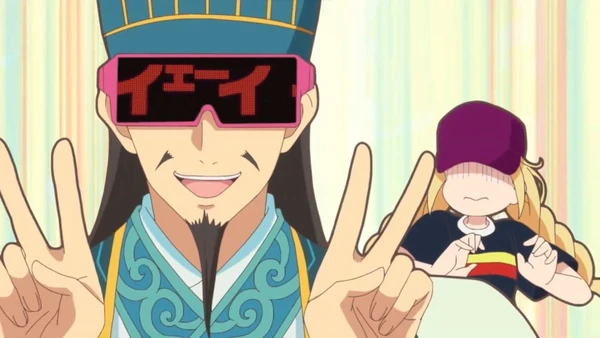
Don't lie; you could hear the opening notes to “Chiki Chiki Bam Bam” in your head as soon as you read the show title. This opening party anthem is only the first glimpse of this stylish, eclectic, and always groovy 2022-vintage anime that combines two great tastes that I never thought would go great together—the Three Kingdoms' genius strategist and the modern EDM (electronic dance music) scene. Ya Boy Kongming! fulfills the “stranger in a strange land” premise that characterizes isekai, but a more accurate term for this centuries-spanning premise is a reverse isekai. Namely, it features a protagonist who finds themself transported from an unfamiliar land to a modern setting, rather than the other way around.
An isekai rebirth couldn't have happened to a more fascinating individual than the famed Zhuge Liang, courtesy name Kongming, who has inspired a handful of anime and manga aside from this one. However, it's not hyperbole to say this adaptation is the most unique out of the bunch, reimagining Kongming and applying his renowned hyper-competency to the world of EDM. It's as if creators Yuto Yotsuba and Ryō Ogawa spun the wheel of historical characters, then threw a dart at the board of niche hobbies and interests, committed to creating a manga about whatever the randomized result is. Of course, I'm being facetious because no gag could be this well-researched; knowledge about Three Kingdoms history and passion for the modern EDM scene shine through every line. This sincerity is especially apparent through characters like Owner Kobayashi, the history-buff nightclub boss, and the young, hangdog, first-rate rapper Kabetaijin. However, there's only one character who matches Kongming's verve and vibrancy, the cheerful aspiring musician Eiko. She hasn't had her big break yet, but Kongming is instantly convinced that it's only a matter of time. He pledges himself to the young woman and offers his skills as her tactician, and here's the beautiful part: There is absolutely nothing weird about it. Nada. I'm currently reading the manga, and there's never a hint of a love affair between the 20-year-old songstress and the much older reborn statesman. Kongming didn't lie to get into Eiko's pants; he believed in her musical flair. (And this loveable, mascot-like iteration of Kongming would never; he just wants to party!)
Translating a show focusing on music and rap is no easy feat. I can't talk about Ya Boy Kongming! without applauding the labor of love that was Jake Jung's translation. “Ya Boy Kongming! episode 6 features a rap battle with about 192 bars… I've translated 200+ eps of anime, and I spent far longer on this than any other,” Jung wrote on Twitter. His efforts paid off to masterful results: a translation that scans along with Kongming's rapid-fire verses. Through Jung's translation, English speakers get to enjoy the delicious weirdness of an ancient Chinese statesman freestyling, peppering in rhymes that make sense just for him, like Kongming folds in a recitation of a classical Chinese poem. It's a rich text that builds up Kongming's character, and each time I re-watch episode six, I notice something new.
I was such a big fan of Ya Boy Kongming!! that after it ended, I read the manga, but it wasn't the same. When Eiko opens her mouth to sing, what it sounds like is left up to the reader's imagination. It's way better to hear the music: “Be Crazy For Me” is so catchy I still listen to it three years later. Still, I would encourage anyone who misses the show to give the manga a try since it continues to up the ante on Kongming's adventures in the music industry: working as a host club's top performer, designing tactics for a parade float in Kyoto, and generally bringing his prowess to increasingly absurd and over-the-top scenarios. The Three Kingdoms and EDM is such an unexpected subject combo, but like chocolate and peanut butter, it feels so right.
Miss Kobayashi's Dragon Maid
Reuben Baron
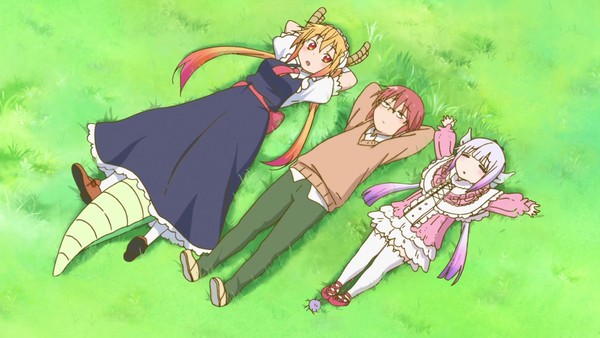
Most of my favorite modern isekai anime tend to be reverse isekai, probably because it tends to focus more on comedy. Miss Kobayashi's Dragon Maid uses the setup of dragons entering the human world for the sake of a charming queer-positive “found family” sitcom with (mostly) lovable characters and exceptional production value. It's not without its problems — it might be the favorite of mine that I have the most difficulty recommending to non-anime watchers owing to certain iffy content — but at its best, Dragon Maid's balance of wholesomeness and horniness makes for wonderful comfort viewing.
At the show's heart is the relationship between Kobayashi, a computer programmer with a maid fetish, and Tohru, a Chaos dragon in human form, doing her best to be Kobayashi's perfect maid. Tohru's much louder in her affections than Kobayashi, who stays more reserved (at least when she's sober), but it's never in doubt that these unlikely roommates are girlfriends, and I love that for them (we are ignoring that one mistranslation in the first episode of the dub). The adorable younger dragon Kanna is their adopted daughter and gets into her misadventures at school.
Outside of the main Kobayashi family, my favorite of the show's characters is Elma, a hardworking Harmony dragon with a sweet tooth and a history of conflict with (and possible feelings for) Tohru; she doesn't appear much in Season 1, but the Season 2 episodes with her backstory and her rematch with Tohru are among the series' best. The dragon/human gamer couple of Fafnir and Takiya are always amusing whenever they show up. I even ended up liking Ilulu — a controversial character due to her physically improbable design and questionable age coding, but one who's often funny and has some genuinely emotional character development. The one character I don't like is Lucoa — the biggest of the big-tiddy dragons is unfortunately at the center of the show's most offensive running gag, repeatedly “accidentally” sexually harassing an 11-year-old boy named Shouta.
Dragon Maid is focused on sitcom shenanigans first and foremost, but it has a solid foundation of isekai world-building. The conflicts between the different dragon factions in the other world are well thought out, enhancing the character relationships and setting up many of the show's most heartwarming moments. Every now and then, Dragon Maid will also drop some of the best-animated action scenes on TV. If Kyoto Animation ever made a traditional battle shonen with fight scenes this awesome, it would be the biggest hit in the world (though isn't it cool that an animation studio of this caliber has consistently chosen to apply its skills to slice-of-life shows instead of becoming MAPPA?).
Yasuhiro Takemoto, the director of Dragon Maid's first season, was one of the victims of the 2019 Kyoto Animation arson attack. Dragon Maid's second season, directed by Tatsuya Ishihara but still co-credited to Takemoto in his memory, was the first new TV anime the studio completed after the attack. These circumstances made me all the more appreciative of the series as a shining example of the KyoAni crew's talent and resilience in the face of tragedy.
Lucoa's whole deal, Ilulu's design, and some questionable camera angles around Kanna are all reasonable dealbreakers regarding Dragon Maid. A problematic fave it may be, the show's beautiful animation, great comedic timing, and essential sweetness keep it firmly at the top of my faves list in the isekai genre. I can't wait for the upcoming movie A Lonely Dragon Wants to Be Loved.
How NOT to Summon a Demon Lord
Christopher Farris
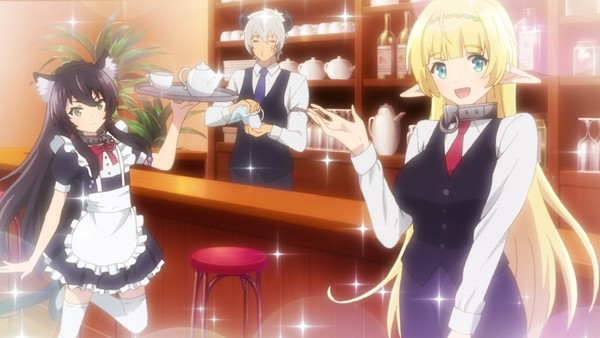
A "hear me out" if there ever was one. How NOT to Summon a Demon Lord is a modern isekai that had to work to put itself over before it dawned on me, to my waking terror, that this was probably my favorite example of the current era of this genre. It is exemplary in that space when it comes to all the usual churlish checkboxes: the lead is an antisocial gamer who's been sucked into his game world and falls into a harem of willing women friends after he winds up enslaving several of them. It is, as far as the back-of-the-box description goes, how NOT to get me interested in a modern isekai.
Right from the jump, Demon Lord sets itself apart through the amazing writing trick of thinking about parts of its premise for more than two seconds. Diablo comes off as an actual representation of a repressed nerd who doesn't get out much. He has zero social skills and is constantly on the precipice of internal and external panic, spiraling as he puts on his blusterous MMO role-play persona in a desperate bid to avoid making eye contact with people. It's great because the story can play it for drama as well as gap-moe comedy, as Demon Lord, several times, shows an earnest interior look at the self-esteem and trust issues that defined Diablo in his previous life. When one of his party/polycule members mysteriously gets compelled into leaving him, he doesn't jump to save her from suspected mind control—he immediately retreats into a depression nap while mulling over what he must have done wrong. It's relatable and makes him feel like a real character compared to many Kirito-shaped ciphers. It helps that they gave him a real character design where I can see why so many of these gals would be immediately drawn to him. The dude is hot, yo.
The appeal of Diablo's interactions with those initially inadvertent live-in subs defines the other component Demon Lord wields way better than I would have expected. It goes a long way to say that the enslavement element was unintentional on Diablo's end, with his first action item and the plot's initial driver being his quest to undo it. This does clear the way for the eventual adoption of the whole bit of Rem and Shera realizing they're Into It, which only flusters Diablo more as he stumbles into a whole different kind of role-play. There's chemistry, is what I'm saying, compounded by Demon Lord's unabashed horny streak being, like, 75% good-natured. Healthy, even.
This is a series that also considers the motivations of kingdoms that court the employ of the first uber-strong adventures that wander in, a power play that quest-givers in other fantasy entries never even think about. Demon Lord is actively concerned with individuals being mindful of interacting with systems of entrenched power and unquestioned leadership, which is way more than I'd ever think I could say about a show where a seven-foot-tall sexy demon man finger-blasts a catgirl on-screen. I think that should make clear how there is nothing quite like Demon Lord, because there's nothing else willing to commit to this level of give-a-shit about its full spectrum of serious and silly, and that's why my standards for even the stupidest isekai now feel impossibly high.
Log Horizon
Jairus Taylor
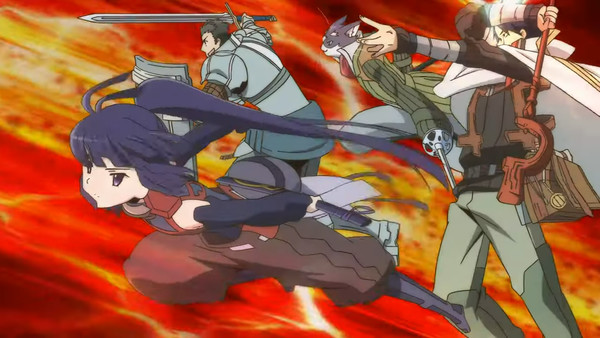
While there have been many an isekai about a gamer guy getting trapped within the world of his favorite MMO or janky RPG, none have connected with me as much as Log Horizon. The story follows a college student named Shiro, who is in the middle of playing the latest expansion of an MMO called Elder Tale when he and the other players find themselves unable to log out. With no way of knowing how to return to the real world, he and the other players are left with no choice but to figure out how to survive in this new world and deal with the dangers presented by both it and the other players. At first glance, its premise has a lot in common with Sword Art Online, which helped to popularize the “trapped in a video game” craze with a similar concept (and both shows came out within close enough proximity of each other that it's hard not to compare them) but their methods of execution differ drastically.
Whereas SAO zeroes in on the survival aspect of its premise, and the characters use their knowledge of the game to escape it or survive for as long as possible, Log Horizon takes an almost opposite approach. Instead, much of the focus is on building up its world as the characters try to figure out the best way to carve out a living for themselves within it, leading to interesting results. As Shiroe and his companions eventually decide to create their own player guild and form various alliances, we start seeing the characters dealing with problems ranging from stopping vicious veteran players from taking advantage of newer ones to figuring out how to create their own functioning economy within the starter town they've been living in. The show gives plenty of time to let these ideas breathe. We also spend a lot of time seeing how the players interact with the existing population of Elder Tale as they quickly discover that they aren't mere NPCs, but people with their own governments and political factions, whom they eventually dub the People of the Land. Since none of these existing governments quite know how to react to the presence of the players, it provides some extra tension as Shiroe has to deal with the machinations of both other players and the People of the Land's rulers, and the show ends up spending as much time on economics and politics as it does big battles.
While a lot of that sounds like it could get boring or overwhelming, the show manages to balance that out with a solid array of fun characters. Shiroe is pretty great in his own right, as he takes the overpowered nature of an isekai protagonist but applies those skills to negotiation rather than combat, and half of the show's appeal is watching his elaborate schemes play out. He's also joined by characters like Akatsuki, a quiet ninja girl who has trouble getting along with other people, Nyanta, a middle-aged man with a humanoid cat avatar (who, depending on which language track you listen to, can be either a lovable cat dad or a cat daddy), and Lenessia, a princess from the People of the Land who is too lazy to deal with politics but finds herself forcibly pulled into the orbit of the players and the effect they have on her world. They all make for a pretty delightful ensemble and give the show enough humor to keep it from feeling slow as it takes more and more time to expand on its world. Despite its video game setting, Log Horizon has some excellent fantasy worldbuilding that few shows can match and leverages those strengths alongside its great cast and earworm of an opening song (once you've heard the lyrics to "Database," you'll never unhear them) to make for a fantastic show. Even with how popular the isekai craze has become, nothing else feels quite like it, and if you haven't given it a watch before, you owe it to yourself to give it a shot.
I'm in Love with the Villainess
Erica Friedman
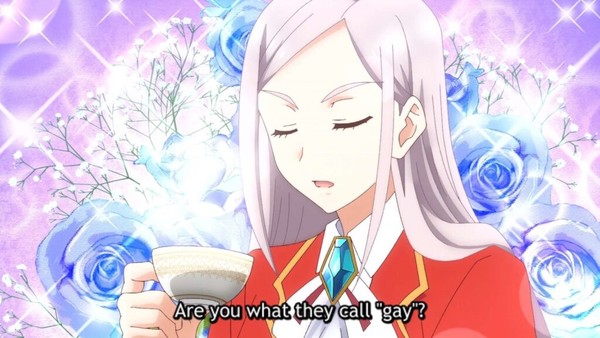
Whether you think of isekai as a place where young girls in anime found their power, or Potato-kun found girls with their mad RPG skillz, or even overworked salarymen blowing off their stress for a slow life in a quasi-medieval village, it is undeniable that finding one's self “in another world,” is impactful for large swaths of the Japanese pop culture audience.
Except me. Where were the butch lesbian villains getting their ill-deserved harems? Or the butchy, bad-ass knights saving damsels? As long as isekai wasn't queer, I didn't care that much. Until inori.'s I'm in Love with the Villainess. This girl-power fantasy about a lonely loser careerwoman who works off her stress with an otome game caught me, shook me hard, and set me down, reborn into another life as a person who saw the possibilities of isekai.
When best-friend character Misha turned to overpowered reincarnated protagonist Rae Taylor and asked, “So, are you what they call gay?” and Rae answered….and a conversation happened in which Rae did not handwave the issue as “love is love,” and then the series just kept getting queerer and queer from there, I finally found an isekai that spoke to me.
It's not a perfect narrative. In the beginning, Rae plays an oversexed fool of a gay character, but the story addresses that directly. Rae herself brings up her background, her traumatic early love interests and discusses how queer characters are portrayed in modern Japanese media.
Critically, as the story develops, so do the issues. The narrative includes whole arcs on the lives of trans folks in a society that does not accept them, internalized homophobia, and the difficulty of changing laws to increase the acceptance of queer folks in society. This series takes a pretty sober look at income inequality, food scarcity, and poverty, as well. All this while telling a story that is a typical quasi-feudal, fantasy isekai, with magic and monsters and demons.
When the story turns itself on its head and finally tells you the truth, this goofy romantic comedy becomes rather more than the sum of its parts. I'm avoiding spoilers here, but you will have to trust me — this is not just a super-queer, quasi-feudal, fantasy otome game isekai story. Like many of the best isekai, it's not at all what it seems.
I also highly recommend the manga, which features outstanding illustrations by AONOSHIMO. The manga has added some extra content to the light novel narrative to fill out the plot, give well-loved characters more page time, and provide amazing illustrations for critical scenes. The manga is still ongoing in both Japanese and other languages. Seven Seas is handling it in English.
So if you want some cute girls finding love with each other rather than a prince, a villainess getting a chance at happiness, and the complete restructuring of an inequitable society, I'm in Love with the Villainess might be the isekai for you, too.
Re:Zero − Starting Life in Another World
Kevin Cormack
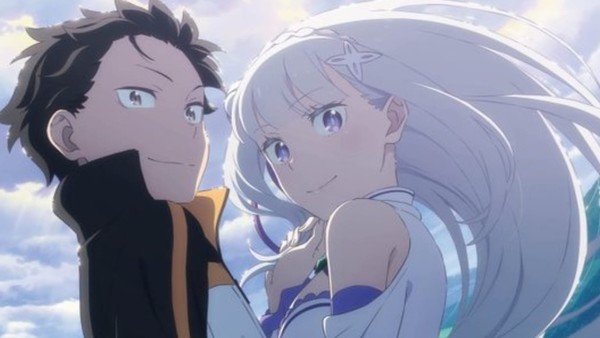
Fantasy stories about characters finding themselves spirited away to strange worlds have always fascinated me – from Lewis Carroll's Alice books and C. S. Lewis' Narnia series in my childhood to the more recent His Dark Materials trilogy by Philip Pullman. The medium of anime is blessed (some might say cursed!) with an overabundance of entries in this genre, with a surfeit of excellent series to choose from. Standing head and shoulders above many others is light novel author Tappei Nagatsuki's epic Re:Zero series, currently sitting at thirty-nine main volumes, eleven short story collections, and six side story volumes. Originally published in 2012 as a web novel on the Shōsetsuka ni Narō site, its popularity undoubtedly contributed to the subsequent meteoric rise of the isekai genre.
Re:Zero's first anime season instantly hooked me with its double-episode premiere, introducing teenage NEET loser Subaru Natsuki, who is inexplicably summoned to Lugunica, a fantastical kingdom populated not only by humans but also animal people, elves, and monsters. With the smugness that comes only with excessive genre overfamiliarity, Subaru assumes he must be a hero with special power, only for him to die swiftly and horribly. Finding himself resurrected, he makes mistake after mistake, his life ending in multiple horrific ways, his life always resetting to a “save point,” where he's forced to try again and again until he gets it right. It's only through repetition and learning from his errors that he forges a path through insurmountable odds while having his assumptions and prejudices continually challenged. Yes, Subaru starts off really annoying – but via excessive, bloody, screaming torture, he becomes a better person. Honest.
Many Re:Zero detractors are put off by Subaru's characterization in the initial episodes, and I completely understand why they may not wish to continue watching – but the character writing in the show is spectacularly good. Once Subaru reaches a certain point in his destiny, his “save point” is updated, and he must live with whatever mistakes he has made, leading to some truly emotionally devastating scenes. Unable to tell anyone of his “return by death” skill, he's witnessed countless timelines where his closest friends are butchered, or worse, with him enduring profound trauma he's unable to offload to anyone. Subaru's growth through suffering isn't the only fascinating aspect of the story – Re:Zero's world is incredibly detailed, with countless moving parts. Supporting characters have histories, complex motivations, and lives of their own, separate from the protagonist. Virtuoso twists and stunning reveals flow regularly from Nagatsuki's pen, giving the impression this is an intricately-planned story, made from ticking gears like a meticulously-constructed, high-quality timepiece.
Season two dramatically increases the complexity, with a phenomenal season-long story arc that repeatedly builds and involutes, culminating in a magnificently intense conclusion. I may never look at bunny rabbits in quite the same way again. The currently-running third season maintains that intensity – never has a show featured such a collection of truly hateful, disturbingly unsettling villains, who all seem insane in their own special, individual ways. It also helps that the animation, especially during the superb action scenes, is consistently of spectacular quality.
I can't finish without praising Re:Zero's wonderfully eccentric and fun extended cast, including the innocent but determined Emilia (best girl – fight me), the mysterious and tragic Beatrice, formidable oni maid siblings Rem and Ram, best-ever-bro Otto, and sketchy clown-faced Margrave Roswaal. Their relationships grow and develop in fascinating ways throughout. I heartily recommend giving Re:Zero a chance – Subaru will eventually become a really compelling protagonist. Please believe me!
Life with an Ordinary Guy Who Reincarnated into a Total Fantasy Knockout
Caitlin Moore
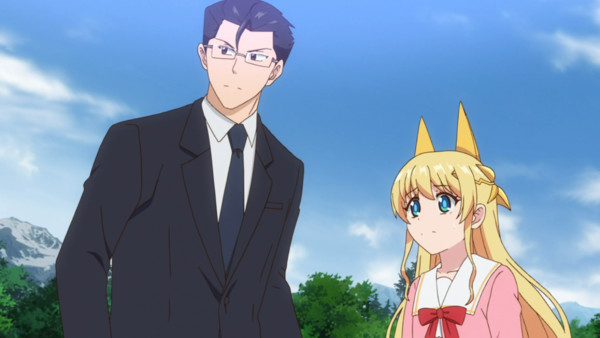
There are a lot of qualities that make Life with an Ordinary Guy Who Reincarnated into a Total Fantasy Knockout special, but some background knowledge is key to truly understanding it. It was created by a married couple, with wife Yū Tsurusaki primarily in charge of the story and husband Shin Ikezawa drawing the art. Tsurusaki stated in an early author comment that her hope was to portray a form of love “not bound by BL or TSF [transsexual fantasy],” but mostly, she just wanted to awaken a new fetish in her readers. The two of them affectionately needle each other in the author notes, giving the image of a playfully antagonistic partnership between two of the kind of people who would create a series like this.
It stars a pair of 32-year-old men who have been friends since middle school: Hinata Tachibana, who is short and unlucky in love, and Tsukasa Jinguuji, who is tall and handsome, but has zero interest in dating the women who surround them. After a night out drinking, Tachibana collapses, crying and wishing he were a pretty girl instead. At that moment, the goddess of love and beauty appears, sending the two into another world and giving Tachibana exactly what he wished for: transforming him into a petite blonde so beautiful that she drives every heterosexual male she encounters mad with lust. The two proceed to wreak havoc in their new world, all the while fighting their sudden mutual attraction.
There's a bit of KONOSUBA in Fantasy Knockout's DNA. It parodies Narou-style isekai with a glee that almost borders on malicious but always pulls itself back right before it gets truly mean. Take Schwartz von Liechtenstein Lohengramm, another Japanese citizen drafted by some deity for a conflict nobody understands. He looks and dresses exactly like Kirito, styling himself as a cool loner when he's just a dorky otaku. He refuses to tell anyone his birth name, insisting they call him by the ridiculously long moniker he's assigned himself. In short, he's a dimwit. Despite this, the narrative really doesn't seem to wish him ill; in the end, he's a nice boy, just kind of stupid. And to be honest, everyone here is a little stupid, or even more than a little. The jokes come fast and thick enough that even if some of them don't land or are a bit too cruel or a bit too heteronormative, a funny one is just around the corner. It's the 30 Rock school of comedy.
It's all about Jinguuji and Tachibana inflicting their weird emotional hangups and codependency on the world around them. Before getting isekai'd, Jinguuji deliberately sabotaged Hinata's love life for fear of losing his best friend, and Hinata did get drunk and start wishing he was a girl… there's a lot to unpack there. And lord help us, those two are determined to do exactly what I do after returning from a long trip: plop the suitcase down and absolutely refuse to acknowledge it. The farcical nature of the story keeps it more as a wellspring of comedy than a frustrating lack of character development. Still, just like when I realize I want to do yoga and there's a suitcase in the way, they have to start unpacking their feelings sooner or later.
Maybe you're here for rapid-fire slapstick comedy. Maybe you're here for a chaotic isekai parody. Maybe you're here for the gender of it all, and you want to let Tsurusaki give you a new fetish… assuming you didn't already have it. No matter what the reason to watch, Life with an Ordinary Guy Who Reincarnated into a Total Fantasy Knockout is a rollicking good time.
Gundam Build Divers Re:RISE
Coop Bicknell
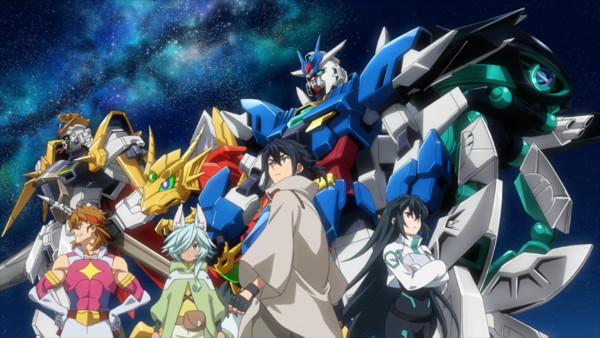
Over my thirty years and change on this spinning rock, I've come to realize that I'm not much of a fantasy (and, by extension, isekai) guy. However, if I hear good things about a show, I'm more than game to give anything a try. 2020's Gundam Build Divers Re:RISE is a perfect example of that mindset in action. It doesn't hurt either that I greatly enjoy giant robots from time to time. Well, that might actually be an understatement...
A sequel to Gundam Build Divers, Re:RISE follows a party of Gunpla (Gundam Plastic Model Kits) MMO players who find themselves mysteriously brought together after they discover a hidden server within the game's code. However, our party quickly realizes they've connected to something that's way more than just a major quest line—they've been transported to another world.
Re:RISE follows the well-trodden path laid down by most MMO isekai stories (like Sword Art Online and .hack) but doesn't shy away from Gundam's trademark meditations on the horrors of war. It's not as nuanced (or nearly as intense) as a Yoshiyuki Tomino-directed Gundam series or The Witch from Mercury, but it's way more than I'd expected from a show designed to sell model kits to kids. And while we're on the topic of younger audiences, I think Re:RISE is a wonderful introduction to Gundam or mecha on the whole. My initial viewing of the series took me back to my days as a second grader—when I'd rush home to make sure I didn't miss the latest episode of G-Gundam. If a show makes me feel like a kid again, even if it's just for a passing moment, I can't help but smile at it.
While there are plenty of references and obscure mobile suits (shout out to Turn A's Wodom) scattered across the series for longtime fans, knowing any of that isn't necessary to enjoy Re:RISE's story—nor is any knowledge of Gundam Build Divers. Some characters from the first series pop up on occasion, but their inclusion only really serves to show off a new model kit or two. On that note, some might find some of these new designs to be a touch overwrought, and I can't disagree with them. However, of the new mobile suits, I love the Core Gundam and its staggering arsenal of planet-based armors. I'm especially fond of the creamsicle-colored Saturnix Gundam and its Gaogaigar-esque drill weapon. But regardless of the specific robot on-screen, the dynamic action direction courtesy of the great Masami Ōbari (Brave Bang Bravern!) is something to behold. With the art of hand-drawn mechanical animation continuing to decline, Re:RISE is worth a watch for that alone in my book.
Ripping myself away from the series' Gundam-specific elements, I enjoy how the series takes what seems to be a standard fantasy setting and hits it with a distinct sci-fi twist. There's also a bit of Seven Samurai and Castle in the Sky peppered in for some extra flavor too. Throughout Re:RISE, the audience comes to understand the specifics of just what's going on with its world. The details around those specifics often end up somewhere between ancient magic and advanced science. One of my favorite examples of this fusion of magic and science is the introduction of a powerful and mighty dragon...who has one of his wings rebuilt out of Gunpla.
Gundam Build Divers Re:RISE isn't exactly an earthshattering series, but it works so well for what it is—be it an introduction to Gundam, another MMO-based isekai story, or a model kit commercial. Similar to what I said earlier, this show makes me feel like a kid again, even if it's for a fleeting moment. If any show can do that, it's a winner in my book.
Isekai Izakaya: Japanese Food From Another World
Jeremy Tauber
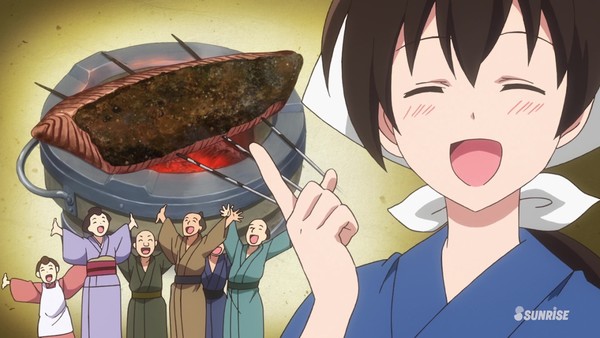
I won't sit here and say that Isekai Izakaya: Japanese Food From Another World is an opus of its genre, but Izakaya's still one of the most charming instances of fantasy light fare I've seen, mainly because it gets to dish itself out in three ways: an isekai that borders on slice-of-life, a cooking show, and a travel show. The way these genres come together isn't too far off from how the ingredients are used in some of the anime's delicious meals.
Like its spiritual sibling Restaurant to Another World, Isekai Izakaya is about a restaurant that opens its doors in, well, another world. Both isekai understand their potential to promote Japanese food as a culinary tour de force in their respective worlds; however, each approaches this concept differently. Along with its episodes being more anthological, Restaurant's RPG elements have the show's logic become statistical by having its otherworldly characters get stat boosts after nomming down a tasty Japanese meal. Izakaya's isekai-isms are softer here, throwing away the typical RPG-isekai trappings so its main cast can enjoy the food without any fancy frills. Almost every single dish's ingredients, means of preparation, and even the way they're plated are on full display here, making Izakaya essentially food porn. Presentation-wise, the shots of the food aren't far off from the ones in the videos that have occupied my YouTube feed for months now. Every food item featured in Izakaya looks immaculate, especially that double-fried karaage, which I would absolutely go to town on if I ever got my hands on it.
As for the slice-of-life elements here, Isekai Izakaya's certainly got the vibes down. Isekai Izakaya is mostly free of conflict, save for a few unruly customers who enter through the restaurant's doors from time to time. The head chef, Nobuyuki, and the waitress, Shinobu, develop as the series progresses, although their personalities are mostly defined by their occupation. There is also a narrative undercurrent running through each episode, with some moments playing out like an episode of Cheers. But this is ultimately food porn, and as they say, you don't typically watch porn for the plot. At the end of the day, all of the characters and setups are just an excuse to display mouthwatering feasts, and speaking as a gluttonous fiend who can make an entire pizza disappear faster than you can say “Houdini,” that's all I need.
Even better is how each episode ends with one of two live segments: one where chef Ryūta Kijima prepares the dish featured in a particular episode and another where actor, essayist, and foodie Kenichi Nagira travels to hot spots throughout Tokyo for the best grub. It makes sense; if your isekai is going to show some tasty anime food, why not show off their real-world counterparts while you're at it? Part of me feels that this turns the show into a Diners, Drive-Ins, and Dives for otaku, and it works. True, the female voice-over providing additional commentary during these segments might seem a bit too overenthusiastic sometimes, but can you blame her? What foodie wouldn't be excited by that golden flash of tempura, the delicate pour of crisp lager, or the spicy red of spaghetti napolitan? Seriously.
My Next Life as a Villainess: All Routes Lead to Doom!
Kennedy
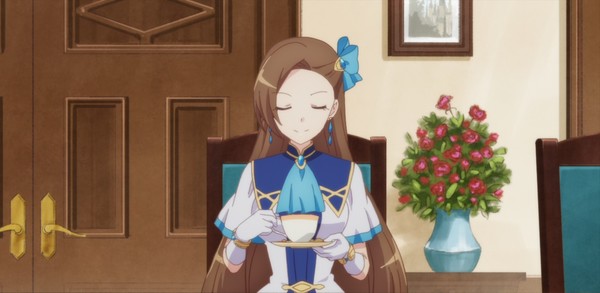
If you've enjoyed any of the recent stream of villainess-centric anime we've got, you have the success of My Next Life as a Villainess: All Routes Lead to Doom! (henceforth Next Life) to thank. A hilarious and mold-breaking take on the musing I'm sure we've all had, “I would've done things so much different or better or whatever if I was in this dating sim!” this series is an incredibly charming and gloriously bi, reverse-harem isekai about an otaku-turned-otome-antagonist.
Next Life follows Catarina Claes—or at least, that's what she's called now. Once a 17-year-old otaku, she died suddenly on her way to school. She pulled an all-nighter playing an otome game. This caused her to be late getting to school, and in her sleep-deprived rush, she ran into the street (classic). The next thing she knew, she woke up in the world of an otome game called Fortune Lover as its villainess, Catarina Claes, albeit years before the game's main events take place. Knowing that there's no happy ending for the villainess, Catarina dedicates herself to trying to dodge and dismantle as many doom flags as possible whilst ensuring that no matter how things shake out when the events of Fortune Lover properly begin, she'll be ready for everything. But in doing so, she accidentally ends up making herself something of a pseudo-heroine; everyone who normally falls in love with the heroine ends up falling in love with her instead—including the heroine herself.
All too often, harem anime protagonists are the character equivalent of saltines and store-bought white bread, with a glass of room-temperature tap water with no ice. But Catarina, ever intent on proving that she's not someone who should be exiled, is a genuinely likable character. She's funny, strategic, hardworking, has a bit of a dorky streak, and also really dense. I thought I was tired of dense harem protagonists before watching this anime, but as it turns out, that can be charming with the right execution. Testament to this is the bi band of Catarina stans—Catarina's many love interests include both men and women, and I'm all the way here for it.
While Catarina is probably the main thing I love about this anime, she's far from the only thing that makes Next Life such a treat. It's also worth talking about this anime's inventive take on the idea of living in the world of a game. While there's nothing wrong with this approach, rather than the more typical .hack (my beloved) or Sword Art Online-esque plot of being whisked away to a game where you're just your own character, in an open world game world where you could meet anyone and you're not strictly confined to a specific in-game story, Next Life has Catarina instead living in a specific, story-driven game, as a specific character within that narrative. We've seen plenty of other villainess titles also do that in the years since (even now, this very season, we're seeing it in From Bureaucrat to Villainess: Dad's Been Reincarnated!), but at the time of Next Life's release, it was pretty novel.
It's easy to take it for granted in 2025, fresh off the heels of the aforementioned wave of villainess anime. Still, making Catarina the villainess was a brilliant idea from a story-writing perspective. The fear of death or exile motivates her actions, which can sometimes feel unusual or unconventional to many of her admirers. More importantly, it lets this anime maintain some stakes even though Catarina already knows exactly who everyone is and what will happen if she sits idly by and lets the events of the game play out the way they do canonically. It's a conceptually clever series with a great protagonist and overall execution to match.
discuss this in the forum (75 posts) |